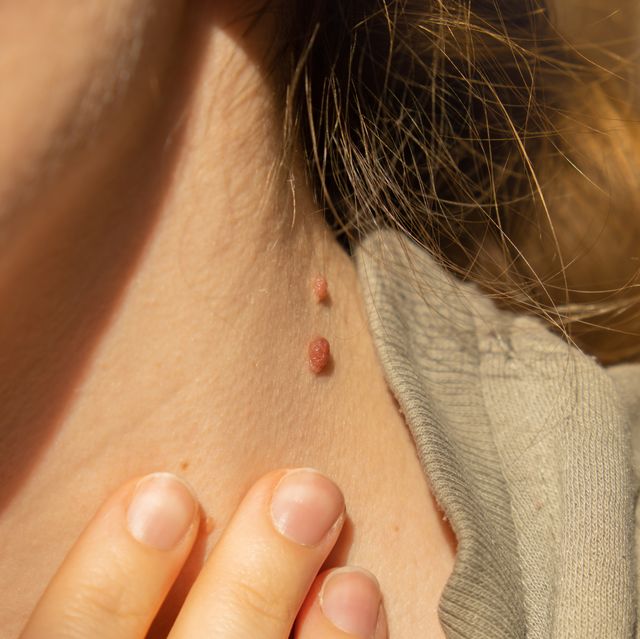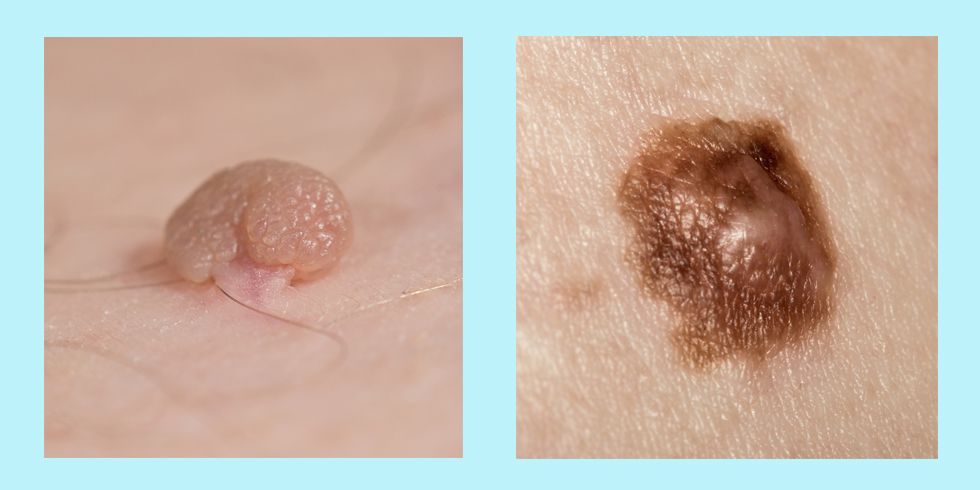Skin tags are usually harmless, but they can make you feel self-conscious or even be irritating if your clothes rub up against them.
We chatted with experts to see how to get rid of skin tags and everything you need to know when they start to pop up.
What is a skin tag, anyway?
Skin tags are small, soft growths on the skin that usually form on the neck, underarms, groin, or eyelids, but they can happen anywhere, explains Allison Larson, MD , board-certified dermatologist with MedStar Health. She notes that most people get skin tags at some point in their lives.
"Skin tags are benign skin growths due to an 'outpouching' of the skin that is connected to the underlying skin," says Sejal Shah, MD , a board-certified dermatologist in New York. The result is a fleshy little growth that protrudes from your skin. Unlike a pimple or a cyst, which causes a raised area of skin, skin tags are attached to the surface of the skin via a thin stalk, giving them a kind of “wiggly,” tag-like appearance.
Skin tags (which are medically called “acrochordons,” if you want to get technical) are small but they can be pesky. The tags, which are typically the color of the person's skin or a touch darker, are usually two to five millimeters in size, although they can sometimes get bigger, according to the American Osteopathic College of Dermatology (AOCD). They often appear in clusters.
Generally, these growths are totally harmless, says Dr. Shah, but they can easily become irritated and inflamed. People frequently complain about skin tags getting caught on clothing or jewelry.
When to see a doctor for skin tags
Again, skin tags are usually harmless, but it's a good idea to get any new growth on your skin checked out, says Joshua Zeichner, MD ., a board-certified dermatologist and the director of cosmetic and clinical research in dermatology at Mount Sinai Hospital. . in New York. "Rarely, some skin cancers can resemble a skin tag," he says. "If the spot looks shiny, scabbed, bleeding, or is changing in color, it probably should be biopsied, even if you think it is just a tag."
You'll also want to contact a dermatologist if you have signs of an infection or you just don't know what your growth is, says Ife Rodney, MD, FAAD , dermatologist and founder of Eternal Dermatology + Aesthetics.
Another reason to visit your doctor for skin tags, per Dr. Zeichner: If it's irritating you. Skin tags are usually located in the neck, armpits, and groin, and your clothes can rub up against them, creating discomfort.
Finally, having a lot of skin tags could signal an underlying health issue, says Gary Goldenberg, MD , a board-certified dermatologist practicing in New York City. "Rapid development of a very high number of skin tags can be associated with developing type-2 diabetes ," he says.
How to get rid of skin tags
Just a heads up: Dr. Larson notes many insurance companies won't cover skin tag removal for cosmetic purposes. However, every insurance company and plan is different—you can check in with yours to see what your coverage provides.
There are four ways doctors can remove skin tags, Dr. Rodney says. Those include:
- Cauterization : That means using heat to burn off the skin tag.
- Cryotherapy : This involves freezing the skin tag with liquid nitrogen, causing it to fall off.
- Ligation : This means tying off the blood supply to the skin tag with a suture. It causes the tag to wither and drop off.
- Excision : This involves cutting off the skin tag with surgical scissors or a scalpel.
"The choice of method depends on the size, location, and individual characteristics of the skin tag," Dr. Rodney says. While none of these options for skin tag removal are exactly pleasant, they are pretty effective and easy—afterward all you'll need is a Band-Aid.
Dr. Rodney adds that the skin is usually numbed before treatment, so it shouldn't be a particularly uncomfortable procedure.
Home remedies for skin tags removal
You may be tempted to just yank or snip them off—but that's not a great idea. "I caution people not to remove skin tags at home because they can get infected and they tend to bleed a lot, which you may not be able to control yourself at home," says Dr. Zeichner.
On top of that, you're more likely to cause a scar or risk only removing part of the skin tag, which would mean going to see the dermatologist for another procedure anyway.
Some people will use dental floss to tie around the skin tag and remove them, but Dr. Rodney suggests avoiding at-home remedies at all costs. She warns that these can cause infections or you may risk confusing a skin tag for something that really needs to be seen by a doctor. Also, take a pass on creams that say they can remove your skin tag. "Despite big promises, the at-home tag-removing creams do not deliver the way you might hope," Dr. Zeichner says.
Dr. Larson adds that these over-the-counter remedies often work by irritating the bottom of the skin tag, which can lead to a lot of inflammation, itching, pain, and discoloration.
How to care for skin tags after they're removed
Once you have a skin tag removed, Dr. Rodney says it's important to take care of the wound properly. "After the removal of a skin tag, it's important to keep the area clean and follow any specific instructions provided by the dermatologist," she says.
According to Dr. Rodney, that usually means doing the following:
- Cleaning the area with mild soap and water.
- Applying an antibiotic ointment to prevent infection.
- Avoiding activities that may irritate the area, like excessive rubbing or scratching.
- Keep an eye on the healing process. If you develop any signs of irritation or infection, contact your doctor.
What causes skin tags?
Dermatologists don't really know what causes skin tags, but there are a few theories. What makes them annoying is that they typically grow in folds of skin or areas where there tends to be a lot of friction—think: armpits, neck, and groin. That might be why you see them pop up in skin folds, says Dr. Shah.
Dr. Larson adds that although we don't know for sure what causes them, there seem to be common risk factors for people who develop skin tags like family history or genetics. Meaning, if your parents deal with skin tags, odds are high that you may develop them as well.
Having obesity can also put you at risk for developing skin tags, Dr. Larson says. Even pregnancy raises your risk of getting skin tags, Dr. Rodney says, noting that it seems to be due to hormonal changes happening in the body at this point.
Age is a major factor in skin tags, says Dr. Rodney. People over 40 are more likely to develop them, and that increases even more over the age of 60.
Although the connection isn't confirmed, according to the American Academy of Dermatology , skin tags may be tied to too much insulin in the blood, and therefore a warning sign of type-2 diabetes or prediabetes.
Can you prevent getting skin tags?
Unfortunately, there's not much you can do beyond staying healthy. "Try to live a healthy life with a well-balanced diet and exercise," says Dr. Zeichner.
To keep an existing skin tag from getting irritated, try to reduce any friction there as much as possible.
Can skin tags be cancerous?
Like any spot on your skin, dermatologists recommend keeping an eye on it. "Rarely a skin tag might not be a skin tag at all, but rather a skin cancer ," says Dr. Zeichner. "No matter what, if you have a new or changing spot, make sure to get it checked out. This includes rapid growth, changing color, or bleeding."
Dr. Larson adds that skin tags are generally a cosmetic issue and although they can point to other conditions, they rarely point to cancer.
If your skin tag is painful, itchy, or starts to seem more like a sore, that's also cause for getting an expert opinion. The bottom line? "If you are not sure if it is a skin tag," says Dr. Shah, “it's best to have it evaluated.”







0 মন্তব্যসমূহ